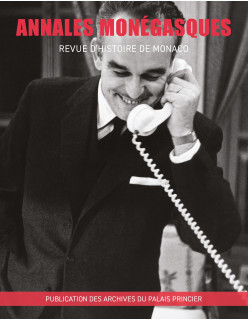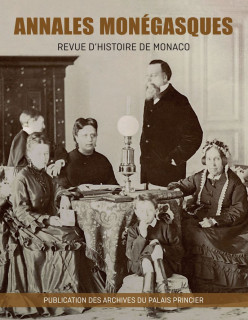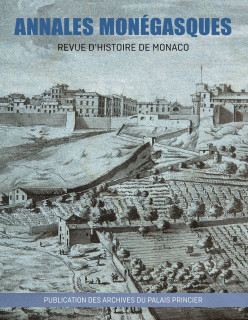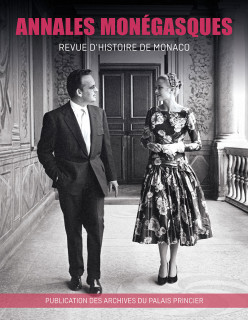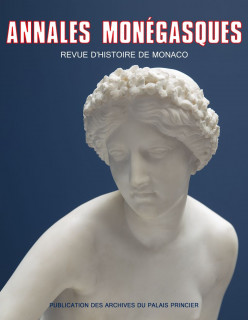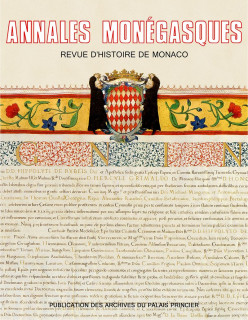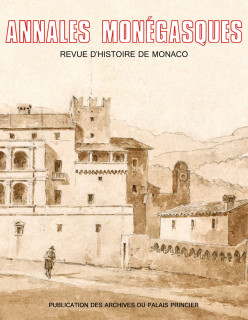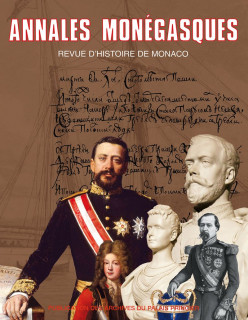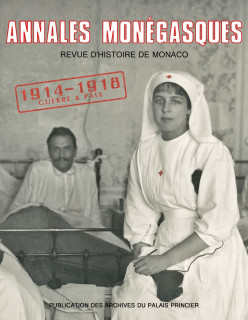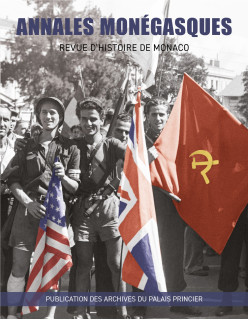
Annales monégasques

Summary
The Middle Ages take centre stage in this 2025 edition, with two articles about the people and events of the period. The first looks at the near-legendary figure of Rainier I, (c. 1267-1314), cousin of Malizia (François Grimaldi) and often regarded as the founding father of the Grimaldi dynasty. Though his feats of exploration and skill as a naval tactician earned him the title Admiral of France, he was never officially “Lord” of Monaco. The second article focuses on the latter half of the 15th century, and the plotting and intrigue between Lord Lamberto Grimaldi (1458-1494) and his wife Claudine’s formidable grandmother Pomelline Frégoso, their bitter feud coming at a time when Monaco’s lordly authority and independence were imperilled by seditious stirrings in Menton and Roquebrune.
Following work to restore the Palace’s Renaissance frescoes, two scholarly art history articles take a closer look at the works of art adorning the walls of the Prince’s residence. The first examines the monumental fresco on the north-east façade of the Cour d’Honneur and its attribution to the artist Caravaggio. The second considers the contributions made in the 1860s by painters Jean Murat (1807–1863) and Jean-Baptiste Carbillet (1804–1888) to the decorative murals in the Hercules Gallery and the York Bedchamber.
In March and April 1861, the naturalist Charles Contejean (1824-1907) embarked on a journey to explore the south of France. The magazine includes a critical edition of his travelogue, describing his experiences in Alpes-Maritimes and Monaco.
Rabagas, a comédie en vaudevilles or comic play by Victorien Sardou (1831-1908), caused something of a stir at its premiere in 1872. Though it features a “Prince of Monaco” grappling with the secession of Menton and Roquebrune, the play in truth engages with broader themes, echoing the revolutionary upheavals that shaped France throughout the long nineteenth century.
The issue also presents two articles inspired by contributions to the symposium “Careers of a Prince – Lives and Territories of Albert I of Monaco (1848-1922)”, held on 24 and 25 September 2022. The first article recounts the discovery of anaphylaxis during one of the “Scholar Prince’s” oceanographic expeditions, a breakthrough that later earned Charles Richet (1850–1935) the 1913 Nobel Prize in Medicine. The second looks at Prince Albert I’s internationalist vision through his relationship with Max Waechter (1837–1924), an Anglo-German industrialist, philanthropist, and pacifist, whose determined Belle Époque campaign for a Federation of European states sought to prevent the breakout of war.
Finally, a booklet of some fifty pages complete with numerous illustrations looks back at the exhibition Monaco Liberated! 3 September – 28 December 1944, which marked the 80th anniversary of the Principality’s liberation from occupation and ran from 3 September 2024 to 31 January 2025.
The literature review continues to highlight recent national and international publications devoted to the history of the Principality and its ruling dynasty.
Summary
The 2024 edition of the Palace Archives history review focuses on the second part of the proceedings of the interdisciplinary symposium entitled “Careers of a Prince – Lives and Territories of Albert I of Monaco (1848-1922)”, held at the Oceanographic Museum on 24 and 25 September 2022.
The chapter Learned life and scientific work begins by looking at the close links forged between Albert I and the Académie des sciences over the Prince’s thirty years of oceanographic studies, while his friendship and collaboration with the Portuguese naturalist Francisco Afonso Chaves are explored through the prism of stereoscopic photographs.
The chapter Political ideals and government includes two articles giving an insight into the Prince’s relations with France: a “French” prince, Albert I was a great friend of Monaco’s larger neighbour, and was in frequent contact with the scientific and political communities in Paris and provincial France, whatever government happened to be in power at the time. Yet he also maintained a close relationship with his closest neighbours, the elected representatives and préfets of the Alpes-Maritimes region. On the domestic front, during the Belle Époque period, his reign coincided with a gradual move towards greater political representation for civil society. The Syndicat d’Initiative des Intérêts Généraux (1907-1909) was one of the first institutional experiments in political consultation, preceding the troubles that culminated in the commune being reorganised, and eventually the adoption of a new constitutional law in 1911.
A substantial part of the volume deals with the subject of Images and depictions of power. On his accession, Albert I chose to celebrate tradition, intent that his enthronement ceremony be a grand spectacle to consolidate his position in relation to his subjects. Throughout his reign, his political stances were the subject of satirical caricature and cartoons, often vicious but always highly inventive, with the casino’s scandalous reputation a frequent target. Like his predecessors, however, Albert I sought to promote an institutional image by issuing coins bearing his likeness and commemorative medals marking prestigious events. An honorary member of the Belgian society of numismatics before his accession to the throne, the Prince once again demonstrated his keen interest in the subject in 1910, when he acquired a collection of Green coins depicting marine animals,
Finally, in the chapter Sports and outdoor life, it is fascinating to recall that, in this year of the Paris Olympics, it was during Albert I’s reign that the Principality joined the International Olympic Committee, with Monegasque athletes making their debut at the Games in 1920.
The bibliographical chronicle continues to highlight the latest national and international publications about the history of the Principality and its dynasty.
Summary
The Palace’s Archives historical review has dedicated its 2023 edition to Prince Rainier III to mark this year’s celebrations of the centenary of his birth.
The section on the exhibition presented in the State Apartments of the Prince’s Palace from 31 May and 20 August 2023 brings together over 300 photographs of Prince Rainier III at home, in his various residences, at the Sovereign’s palace in the exercise of his duties, and in places where he spent time with family.
The first known seal of the Grimaldi family — an imprint of Rainier I depicting a horse in battle and dating from 1305 — enjoyed long posterity within the dynasty until the 18th century. Partly thanks to its namesake, the seal was made popular again by Rainier III, who, at the start of his reign, chose the imprint for coins, stamps and decorative items as part of a strategy of legitimisation and communications.
Upon his accession to the throne, Rainier III chose Jacques Rueff (1896-1978) to be his first Minister of State. This decision heralded a bold political vision for the Principality. Alongside this world-class economist, in 1949 and 1950 the Prince laid the foundations of the decades that followed, in a context marked by diplomatic difficulties with France and a domestic crisis.
A philatelist at heart, Prince Rainier continued to enrich and promote the collection inherited from his ancestors. The Sovereign paid keen and close attention to the issuing of Monegasque stamps, which were made using copperplate, rotogravure or offset printing techniques.
A well-known episode in the reign of Rainier III — the Franco-Monegasque crisis of 1962-1963 — was resolved using an original approach: postal diplomacy. The breakdown of the Neighbourhood Agreement had a significant impact on the daily mailing habits of the Monegasque population for several months.
Aware of the role played by yachting in the Principality’s attractiveness abroad, Rainier III, a sailor and scuba diving fan himself, enjoyed exploration cruises and family excursions. Between the beginning and the end of his reign, he owned a dozen sailing and motor yachts, as well as Riva motorboats and other small vessels.
The “Bibliographic chronicle” continues to report and extensively review the latest national and international publications on the history of the Principality and the Grimaldi dynasty.
Summary
To mark the end of commemorations celebrating the centenary of the death of Prince Albert I, which took place throughout 2022, the Annales monégasques are publishing part one of the proceedings of the symposium entitled Careers of a Prince. The Life and Lands of Albert I of Monaco (1848-1922), held in Monaco on 24 and 25 September.
The first theme, Sports and Outdoor Life, features a richly illustrated monograph that highlights the pioneering nature of Prince Albert’s motorcycling exploits. Between 1903 and 1905, he crossed France several times, travelling between Monaco and Paris on a Humber Beeston motorcycle. His autobiographical journal tells a fascinating, precious, previously unseen story of the early days of motorcycling during the Belle Epoque, when the practice was still somewhat perilous. Hunting, another of the Prince’s favourite sporting pastimes, merited an in-depth study. The numerous documents available paint a picture of a man who favoured a sensible and rational approach to hunting, indicating that Albert I was somewhat ahead of his time, anticipating contemporary debate on the issue.
On the theme of Politics and Power, an article looks at one of the momentous events that marked the young Prince Albert I, namely the funeral of Victor Hugo, which took place on 2 June 1885. In a letter to his father, the Prince related what he had seen, incognito amid a vast crowd. His admiring and respectful account is close to the spirit of reports carried in the moderate press.
The theme of the Prince’s International Reach and Commitments is covered by three articles. The first looks at the Princely paradoxes around colonialism. Albert I’s stated opposition to colonialism was belied by his investments in a colonial business in Mozambique (the Madal company), and his faith in colonial arrangements between powers as a way of keeping the peace. The second article examines his meeting with Mirza Riza Khan, an Iranian diplomat and pacifist who was his country’s first delegate at the League of Nations and the First Hague Peace Conference. His move to Monaco, in 1910, to live in the Villa Ispahan, forged a cultural connection between East and West. The third topic covered is Monaco’s contribution, made at the Prince’s behest, to the treatment and convalescent care of wounded allied soldiers during the First World War, in temporary hospitals and convalescent homes set up in the Principality.
The theme Scientific Life and Work also includes three articles. The first shows how, although Prince Albert I is known for his work in the field of prehistoric research, he also took a close interest in the anthropology of modern mankind, and later supported research into human fossils. This little-known aspect of the Prince’s work provides an insight into his intellectual frame of reference, and helps to explain some of his scientific and philosophical choices. The next topic concerns the Prince of Monaco’s contribution to issues of marine security and the preservation of fish stocks, at a time when shared resources such as the ocean were the subject of diplomatic negotiations. Finally, a study looks at the Prince’s role, as a member from 1885, with the Société de géographie de Paris, the oldest geographical society in the world.
The last theme, Artistic Culture and Patronage, looks at the creation on 7 February 1907 at the Opéra de Monte-Carlo - which is to say, in a monarchy - of the opera Thérèse by Jules Massenet, which takes place at the time of the French Revolution. The creation of this opera offers insights into Albert I’s political and artistic sensibilities. The final article attempts to paint a portrait of the “elusive” Princess Alice of Monaco, the Prince’s second wife, as seen through the eyes of her contemporaries. Beloved, adored, celebrated, envied, and sometimes hated, she promoted the cultural life of the Principality for fifteen years.
Summary
Military history is in the spotlight this year. While a first study attempts to restore the way of life and the identity of the soldiers of the Spanish garrison of Monaco, installed in the Principality between 1605 and 1641 within the framework of the Spanish protectorate, another article tells the story of the military career of Prince Honoré III at the head of the regiment of Monaco, in the French army, between 1739 and 1749, during the War of the Austrian Succession.
Important item in the collections of the Prince's Palace, a portrait of Jeanne Grimaldi Trivulce, sister of Honoré II, dated from the beginning of the 17th century and until now attributed to the Provençal painter Bernardin Mimault, is the subject of a new attribution: Alfonso Pozzobonelli, a Milanese.
Contemporary history is also the subject of several subjects. The two medals struck in the monetary workshop of the princely palace at the end of the reign of Prince Honoré V are interpreted as a mirror of sovereignty, through the reflection of two particular events: a visit by the consul of France, and the development of 'a bridge over the Careï, in Menton, in 1838.
Lichtenstein Castle in Württemberg houses to a French library of around 3,500 volumes, much of it from Princess Florestine of Monaco's legacy of her father Florestan I. His installation in Germany result from the alliance in 1863 between this sister of Prince Charles III and Frederick William of Württemberg. A study of the titles present in this library allows us to understand part of the tastes and literary culture of the Grimaldis of Monaco in the 19th century.
In preparation for the commemorations of the centenary of the disappearance of Prince Albert I in 2022, an article reviews the conditions and context of the publication of the first edition of his major work: La carrière d’un navigateur, in 1902. This The study follows the one, published in 2020, on the writing of these autobiographical accounts in the form of journal articles.
As an epilogue to the subject of the Spanish garrison in Monaco, the document of the year looks back on his expulsion from the Principality on November 17, 1641, from a source never before studied, a contemporary French testimony, published only one month ago after the event.
(full texts in French)
Summary
Prince Honoré III was born three hundred years ago, in 1720, , and reigned over the Principality for sixty years, from 1733 to 1793. An Art History article pays tribute to him through the study of portraits realized by a rediscovered painter named Marie-Anne Loir, whose work is a part of the Palace collections.
The continued restoration program of the Renaissance frescoes of the palace generated a study and a strong iconographic file on Ferdinand Wagner, a painter from Augsburg recommended by the Count of Württemberg, brother-in-law of Prince Charles III, who restored and created a part of the painted decorations of the Cour d'Honneur of the princely residence in collaboration with two other German painters in the years 1860-1870.
The mythical book of Prince Albert I, whose centenary of death will be celebrated in 2022, La Carrière d’un navigateur, has never been studied. The first edition of the book, which is a collection of autobiographical narratives, published in 1902, was preceded by the publication of articles from 1888.
Princess Alice, second wife of Prince Albert I, got known to a certain social, artistic and literary background, quite representative of European society at the end of the 19th century. In particular, she forged relationships with Oscar Wilde, Pierre Loti, Margaret Brooke, Frank Harris, Isidore de Lara, who are still known today or have fallen into oblivion...
The appointment of a new Archbishop of Monaco at the start of 2020 is an opportunity to examine episcopal heraldry in the Principality from the end of the 19th century. Symbolic representations obeying codes from the Middle Ages, ecclesiastical coats of arms are intended to reflect the personality, origins, or pastoral program of their bearer.
Contemporary history is evocated through a figure from the early reign of Prince Rainier III, Martin Dale. In 1960, this twenty-eight-year-old former American diplomat was appointed private advisor to the sovereign, responsible for attracting investment from across the Atlantic to the Principality and transforming it into a financial center of international stature.
The Franco-Monegasque crisis of 1962-1963 has slowed down the reform momentum. Martin Dale is accused of privileging American interests to the detriment of France. Despite pressure from General de Gaulle, he continued his mission until 1964.
In this time of COVID-19 pandemic, the “document of the year” section takes us back to 1656, when the baroque and brilliant Queen Christina of Sweden, who came from Rome, wanted to make a stopover in Monaco, while the plague was raging in Italy. The sanitary precautions and the political prudence of Prince Honoré II led to the envisaged stage being only a passage at sea, the story of which is kept in the archives of French Foreign Affairs.
Text in French
Summary
The summer 2019 exhibition, presented in the Great Apartments of the Palace of Monaco and dedicated to the first meeting of the American actress Grace Kelly and Prince Rainier III chick took place on May 6, 1955, is transposed in a notebook of fifty pages and abundantly illustrated. This exhibition has been designed by the Archives and Library service of the Princely Palace and the audiovisual institute of Monaco.
The medieval era is evoked through a specific episode in the History of Monaco: the sale and purchase of the Grimaldi lordship to the dolphin of France, in the context of the expansionist actions of tis big neighbors: Genoa, Savoy and Milan.
As an Art-lover Prince, Honoré II greatly built the collections of the Palace in the seventeenth century. As part of the study program about former princely art collections, which started several years ago, the Prince’s liking for painting is analyzed through his personal correspondence.
Another study about art History is dedicated to the Fabergé egg which joined the Princely collections in 1974. This masterpiece of goldsmithing and watchmaking found its place in the official chronology of imperial and pendulum eggs.
Contemporary history is in the spotlight with several subjects: the history of the cemetery of Monaco, from its origin in 1868 to the present day, in the context of the evolution of mentalities and mortuary customs; the role of Prince Albert I in scientific relations between research centers on the coast and the "seabeds" of Villefranche and Monaco at the end of the 19th century and the beginning of the 20th century; the life of Robert W. Service, a Scottish writer famous in the English-speaking world and author of the novel The Poisoned Paradise. A Romance of Monte-Carlo, published in 1922, which depicts a fantasized portrait of Monaco in the “Roaring Twenties”; as Prince’s Rainier III advisor in 1965-1967, Claude de Kémoularia played an important role in the outcome of the crisis between the Monegasque State and Aristotle Onassis; Relying on the advisor's personal archives, an article reviews this episode and decodes the government machineries of the principality in the 1960s.
Summary
The two hundred and fiftieth anniversary of the birth of the Monegasque sculptor François-Joseph Bosio (1768-1845), eminent representative of neoclassicism in the early nineteenth century, offers the opportunity of two studies: a monograph of an emblematic work, unique and multiple, the Henry IV child, by a curator of the Louvre; a historiographical retrospective on the representation and the monegasque memory of the artist, erected as a national hero. The tercentenary of the foundation of the city of New Orleans gives the opportunity to a specialist of French emigration in the United States to be interested in the ascendants of Alice Heine, "first American princess of Monaco", second wife of Prince Albert I, whose Alsatian maternal family joined Louisiana in the early nineteenth century, after passing through Santo Domingo and Cuba.
The three hundred and fiftieth anniversary of the birth of the composer Couperin reminds us that he had found a muse in Monaco, in the person of a daughter of Prince Antoine I, to whom he dedicates a harpsichord piece. Granddaughter of Lucien Bonaparte, Marie Rattazzi (1831-1902) was a prominent woman of letters and a salonnière in vogue at the end of the 19th century. She frequented Monaco and its princes, wanting to be the muse. To evoke the relation to the sea of Albert I may seem to belong to the commonplace, repeated to envy. The reflection still remained to be led, from three angles, all experienced by the prince during his career as a navigator: at once shipwrecked, rescuer and protector of the maritime environment. In 2017, the "Explorations de Monaco" were launched to better "love, know and protect" the oceans, in the wake of Prince Albert I's expeditions. Madeira was the first stage and was the site of an exhibition dedicated to the discovery of the archipelago, between 1879 and 1912, by the "prince scientist". A thematic file reports on the event. The current restoration campaign of the palace's painted decorations has brought to light, not only a set of new Renaissance frescoes in the Grand Apartments, but also an unpublished archive, which is the "document of the year", and which gives, for the first time and irrefutably, a name, probably among others, for the realization of the wall paintings of the sixteenth century.
Summary
The Monegasque commemoration of this year have strongly influenced the topics of this issue. Indeed, two hundred years ago, in 1817, the Stupinigi agreements linked Monaco to the kingdom of Piedmont-Sardinia. From the 1848 secession to the official end of the Sardinian protectorate of the Principality in 1860, many vicissitudes have been heard. In 1917, a century ago, the battle of the “Chemin des Dames” gave the opportunity to the future Louis II to shine, as he was a volunteer within the French army. A notebook transposes the exhibition dedicated to the prince’s route during the Great War and has been shown to HSH the Prince Albert II in spring of 2017. Armand Lunel died fourty years ago, in 1977. Philosopher and writer less recognized today than he was previously, he taught over a lifetime in Monaco and was granted the Théophraste-Renaudot prize.
Further to the great exhibition of this year in the Nouveau Musée national de Monaco about Hercule Florence, curious inventor of the 19th century, the first pages of his autobiography dedicated to his youth spent in Monaco have been published, annotated and commented. As part of the curriculum on the ancient princes’ art collections, a point about Rubens is made in this issue. An iconic and illuminated document from the Archives of the Palace is here highlighted : Hercule I’s doctorate diploma in canon and civil law, dated 1584. The former dynasty fiefs are presented through an architectural monograph of the castle of Torigni located in Normandy and which was one of the Princes’s residence in the 18th century. The modern historical period is also mentioned thanks to various relationships maintained by Monaco and Venice in the 17th and 18th centuries. To finish with, in order to satisfy the collectors, a study is dedicated to a topic which may look anecdotal : the Monegasque matchboxes from the 19th to nowadays, the evolution of which reflects another image of the Principality.
Summary
This issue is mainly dedicated to culture. During the modern era, some princes of Monaco proved to be paints and books collectors. Some of the Rembrandt works are studied through Jacques I’s collection, and the library, which was scattered during the French Revolution, is now “brought back to life”. The epistolary relationship between Princess Alice and the writer Pierre Loti, is highlighted. The cultural aspect, in the sociological meaning of the term, is dealt with a study about Prince Honoré II’s funerals. Furthermore, an article describes the war, waged by Charles Grimaldi, in support of Anjou in the late Middle Ages, while another article refers to the disagreements in the press, during the separation of Menton and Roquebrune in the middle of the 19th century. To finish with, the document of the year is dedicated to the 150th anniversary of the creation of Monte-Carlo. (full texts in French)
Summary
On the occasion of the Russian year, and in order to make a link with the Russian exhibition which took place in the Palace of Monaco during summer 2015, a large part of this issue is dedicated to the relationships between the Grimaldi dynasty and Russia, and more precisely the Romanov family. Then, a study about the commercial relationships between the Principality in the Black sea and the Crimea in the Middle Ages, completes this issue. Two other articles deal with the correspondence of Prince Albert I with Massenet, and the history of Monaco pavilion at the universal exhibition. After that, two parts pay tribute to Princess Catherine-Charlotte de Gramont and Prince Pierre, and the document of the year refers to the wedding of Louise-Hippolyte in 1715. (full texts in French)
Summary
This issue, published on the occasion of the First World War's centennial, is exclusively dedicated to this war in Monaco and around. Through different aspects, we understand the role that Monaco played in this conflict, in particular regarding its princes’ actions as soldiers and in favour of peace. (full texts in French)


